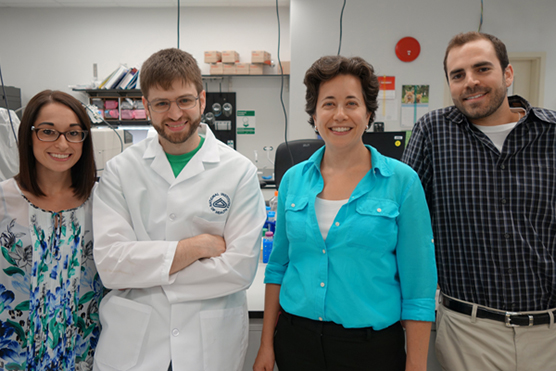Partnering with Disease Foundations to Speed Drug Discovery
When scientists who specialize in drug development have a promising idea for a new disease treatment, they often start by designing biological tests called assays. By using high-throughput (robotically assisted) screening, researchers use the assays to evaluate hundreds of thousands of compounds with the potential to become new treatments. This complex process requires teamwork to involve the right types of expertise and perspectives in the research project team.
Designing high-throughput screening assays is a science in itself. The team must have in-depth familiarity not only with assay technology but also with the target disease and its unique challenges. When the disease is rare, limited information can present additional challenges.
As director of NCATS' Assay Development and Screening Technology Laboratory, Jim Inglese, Ph.D., leads a team of experts who take on these challenges every day. To increase the likelihood of success, Inglese encourages postdoctoral researchers who are knowledgeable about specific diseases to join project teams through fellowships sponsored by patient groups and foundations.
These fellows bring strong disease expertise to NCATS, where Inglese mentors them in broad translational capabilities including assay development and early drug discovery. The overall goal is to develop new technologies and methods to build better disease models that can help advance the search for potential treatments.

Several of NCATS’ Assay Development and Screening Technology Laboratory postdoctoral fellows (from left to right): Brittany Wright, Adam Fogel, Melissa Mendez and Michael Iannotti.
"The fellows gain experience analyzing large-scale data sets obtained with their assays," Inglese explained. "As biologists, they learn to identify meaningful pharmacological relationships between chemical structures of the compound libraries and the concentration-dependent activity displayed by these substances. Usually, you can only get this kind of training at a pharmaceutical company."
The fellowships exemplify NCATS' mission to improve methods and tools to speed the translation of laboratory discoveries into new treatments for patients. They also enable Center researchers to work directly with patient and disease groups as equal partners, each side bringing crucial skills and expertise to the collaboration.
Not Your Average Fellowship
Inglese has mentored five fellows:
- Adam Fogel, Ph.D., Michael J. Fox Foundation for Parkinson's Research
- Michael Iannotti, Ph.D., Alpha-1 Foundation
- Sung-Wook Jang, Ph.D., Charcot-Marie-Tooth (CMT) Association
- Melissa Mendez, Ph.D., Hannah's Hope Fund
- Brittany Wright, Ph.D., CMT Association
Training under Inglese prepares the fellows to pursue careers in academia, biotechnology and pharmaceuticals, or the nonprofit sector, thus disseminating the expertise that they gain while at NCATS far beyond the specific research projects they conducted. Fellows have contributed to a number of important research findings as well. For example, Jang was part of a team that identified a potential drug target for a subtype of CMT, an inherited neurological disorder, in 2012. After completing his fellowship, Jang became director of the early discovery initiative at the Cure Huntington’s Disease Initiative.
For another project, Inglese, Fogel and colleagues employed a technique developed in Inglese's lab called bioluminescent reporter coincidence detection to develop an assay that can sense subtle increases in the expression of a gene called PARK2. This assay is especially relevant for Parkinson’s disease drug discovery because compounds that change PARK2 expression may help slow or stabilize the disease.
"Being able to fund a full-time postdoctoral fellow at NCATS working specifically on our disease is amazing," said Lori Sames, founder of Hannah's Hope Fund, a nonprofit dedicated to research on treatments for giant axonal neuropathy (GAN), a progressive neurological condition. Sames' daughter has GAN, and the organization began supporting a fellowship for Mendez to research potential new treatments at NCATS in 2014. "The expertise, bioinformatics and robotics at NCATS are unparalleled," she added. "To have Dr. Inglese's oversight, with his wealth of experience, is very valuable."
Mendez has expertise in neurofilaments and their abnormal buildup in GAN. Neurofilaments, which reside in neurons and run the length of axons, help brain cells talk to each other. Her experience made her a good fit for GAN assay development; working with Sames and meeting GAN patients and families is "a big motivator" for her. "Everything at NCATS has been so collaborative," she said.
Looking Beyond the Target
Although the assays developed through these fellowships target specific diseases, each assay is based on broadly applicable technology and ultimately may be used to search for potential treatments for other conditions. "There is a drive here, not simply to answer the immediate question, but to recognize that the proximal question is just a piece in a very big puzzle," Mendez explained.
In most laboratories, Inglese noted, "You can either focus on the technology or focus on the disease. But at NCATS, we do both. There's a strong emphasis on developing technologies and methodologies that are broad enough to cross diseases and reach more patients."
These collaborations provide unique opportunities for the disease foundations, fellows and Inglese himself. "It's gratifying when patients come to the lab and see us working on projects that can benefit them," Inglese explained. "That interaction is something I never expected out of a career in science."
Posted June 2015


